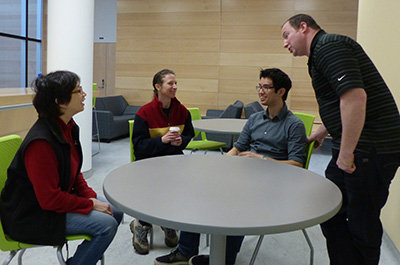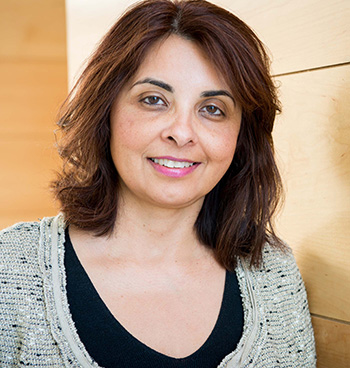Lillian Wong’s life took a sharp turn on a snowy highway outside Penticton 30 years ago.
Heading back to college in Alberta after visiting family in Vancouver during winter break, Wong was riding in the rear compartment of a station-wagon – tucked among bags of hers and her classmates, not wearing a seatbelt – when the vehicle rear-ended a tractor-trailer. Wong was thrown forward, breaking her neck and suffering a severe brain injury. She was in a coma for 16 days.
Wong emerged with poor balance and muscle control, and a lazy eye. But more important, she has struggled ever since with reduced concentration and diminished short-term memory, and she struggles with multi-tasking.
“They didn’t think I could live independently,” she recalls. “They were looking into group homes for me. They were thinking I couldn’t go back to school, or couldn’t work in any capacity that wasn’t menial in nature.”
Wong exceeded those expectations. She went back to college, earning a second bachelor’s degree in cross-cultural studies, then two master’s degrees. But she still has problems with memory and concentration.
So when she learned of an experiment at UBC aimed at helping people with traumatic brain injury (TBI) regain some cognitive capacity, she signed up.
The experiment is the first of its kind – exploring whether a regimen of “brain training” can improve cognition in people grappling with the effects of TBI, and even alter the brain’s structure and connectivity.
The training, like most training, isn’t fun. Forget about Sudoku, or even the satisfaction that comes from learning another language.

Volunteers in the traumatic brain injury research project, during a break from training. L-R: Lillian Wong, Carolee Knight, Kieran Neuenfeldt and Jason Baroni. Photo by Brian Kladko
Wong and her fellow participants gather in a windowless room in the Djavad Mowafaghian Centre for Brain Health four days a week for three to six months, where they work individually, mostly at cubicles, on a series of mental exercises: deciphering the time displayed by a clock with multiple hands (sometimes more than three) or looking at sequences of unfamiliar symbols and trying to remember the exact order.
The exercises were developed at the Arrowsmith School in Toronto, which caters to children with learning disabilities. Founder Barbara Arrowsmith-Young believes that her methods re-wires children’s brains, so that, after two to four years, students can hold their own – even thrive – in conventional schools.
The Arrowsmith program was brought to the West Coast by Howard Eaton, who established the offshoot Eaton Arrowsmith schools throughout the Lower Mainland (including one in rented space on UBC’s campus) and in Redmond, Washington.
The Arrowsmith program has operated without much in the way of scientific validation; instead, the schools have relied on their own internal assessments of their effectiveness, and anecdotes about their alumni’s later success. But its unconventional approach has won over thousands of paying parents, and a handful of Canadian, U.S., Australian and New Zealand private schools have adopted the program for some of their students.
As word of the schools’ program spread, they began to get inquiries from people struggling with a different set of learning disabilities – those resulting from traumatic brain injuries. Eaton and Arrowsmith-Young wondered if these unsolicited clients were on to something.
This time around, however, they decided to do things differently: First, they would get scientific validation.
A study of the child-oriented program, begun in 2014 by UBC Professor of Physical Therapy Lara Boyd, was already underway, funded by Eaton and Microsoft CEO Satya Nadella. Through Dr. Boyd, they found their way to her colleague in Physical Therapy, Naznin Virji-Babul, an Assistant Professor who specializes in brain trauma.
With $ 95,000 in funding from Arrowsmith-Young, Dr. Virji-Babul has set out to determine whether the Arrowsmith regimen can alter the cognitive abilities and behavior of people with traumatic brain injuries, and whether it has a discernable effect on the brain’s structure and activity.
The brain’s structure is being evaluated by looking at myelin – the fatty substance that coats and insulates neurons, allowing electrical impulses to travel more quickly. (Multiple sclerosis results from a degradation of myelin.) Electroencephalograms (EEGs) will measure brain waves to examine patterns of neuronal connectivity, looking for pattern changes over time.
Initial results are already intriguing. Dr. Virji-Babul’s team has found that people with chronic TBI, before starting the intervention, have less myelin compared to controls (people without TBI) – something that has never been noted before. In addition, people with TBI show increased brain connectivity on EEGs.
Interested in donating
to this research?
Contact: Fatima Hassam,
Associate Director of Development
Phone: 604.822.8079
“As a result of their injury, part of the brain is working harder,” explains Dr. Virji-Babul, a member of the Vancouver Coastal Health Research Institute. “It’s akin to what happens to aircraft traffic during a snowstorm that shuts down one airport. The other airports in the network have to pick up the slack and become much busier. In the case of our participants, the prefrontal cortex, which controls reasoning, working memory, self-control, flexibility and problem-solving, is working harder to make connections.”
Dr. Virji-Babul intends to publish whatever she and her team find. But if they find objective evidence that interventions like Arrowsmith’s can have a positive impact, and that evidence can be replicated by other studies, it could be a boon to people wrestling with the consequences of traumatic brain injury.
The standard approach for people with TBI is mostly compensatory in nature – accepting the person’s lack of concentration and memory as a permanent disability, and helping people find an alternative way of coping with those deficits. Arrowsmith’s promoters hope their program can restore concentration and memory.
“We want to find out if it’s possible to reacquire function,” says Mark Watson, Chief Executive Officer of Eaton Arrowsmith. “We’re trying to re-build brain capacity. If it works, people with traumatic brain injury could be looking at a much more independent, fulfilling life.”
